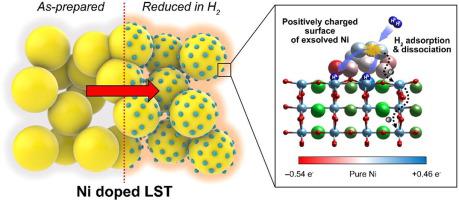Journal of Industrial and Engineering Chemistry ( IF 5.9 ) Pub Date : 2021-07-30 , DOI: 10.1016/j.jiec.2021.07.037 Jong Jun Lee 1 , Kyeounghak Kim 2 , Kyeong Joon Kim 3 , Hyung Jun Kim 4 , Young Min Lee 1 , Tae Ho Shin 5 , Jeong Woo Han 4 , Kang Taek Lee 3

|
(La,Sr)TiO3 has been investigated as a promising anode material for solid oxide fuel cells (SOFCs) owing to its high electronic conductivity and superior phase stability. However, the low catalytic activity of (La,Sr)TiO3 materials is a major obstacle to the application of SOFCs. Exsolution has emerged as an effective strategy to overcome the low catalytic activity of (La,Sr)TiO3 materials. In this work, Ni-doped A-site-deficient La0.4Sr0.4TiO3-δ (LST) (i.e., La0.4Sr0.4Ti0.94Ni0.06O3-δ; LSTN) with in-situ exsolved Ni nanoparticles (NPs) was developed and the effects of exsolved Ni NPs on H2 oxidation was investigated. The doped Ni was exsolved and formed NPs on the LSTN surface under reducing conditions. Owing to the high catalytic activity of the exsolved Ni NPs, the SOFC with LSTN-Ce0.9Gd0.1O2-δ (GDC) yielded a maximum power density of 0.46 W cm−2 at 850°C, 91% higher than that of the cell with LST-GDC, as well as high long-term and redox stability. Furthermore, density functional theory calculations revealed that the adsorption and dissociation of H2 were more favorable for exsolved Ni NPs than for pure Ni owing to the more positively charged surface of the exsolved Ni NPs in the LSTN. These results demonstrated that exsolution is an effective method for improving the electrocatalytic activity of perovskite (La,Sr)TiO3 materials.
中文翻译:

Ni纳米颗粒的原位脱溶以在A位缺陷La0.4Sr0.4Ti0.94Ni0.06O3-δ上实现活性稳定的固体氧化物燃料电池阳极催化剂
(La,Sr)TiO 3因其高电子电导率和优异的相稳定性而被研究为一种有前途的固体氧化物燃料电池(SOFC)阳极材料。然而,(La,Sr)TiO 3材料的低催化活性是SOFCs应用的主要障碍。脱溶已成为克服 (La,Sr)TiO 3材料催化活性低的有效策略。在这项工作中,Ni 掺杂的 A 位缺陷 La 0.4 Sr 0.4 TiO 3-δ (LST)(即 La 0.4 Sr 0.4 Ti 0.94 Ni 0.06 O 3-δ ; LSTN)与原位开发了外溶的 Ni 纳米粒子 (NPs),并研究了外溶的 Ni NPs 对 H 2氧化的影响。在还原条件下,掺杂的 Ni 在 LSTN 表面上被溶解并形成 NPs。由于外溶 Ni NPs 的高催化活性,具有 LSTN-Ce 0.9 Gd 0.1 O 2-δ (GDC)的 SOFC在 850°C 下产生的最大功率密度为 0.46 W cm -2,比具有 LST-GDC 的电池,以及高长期和氧化还原稳定性。此外,密度泛函理论计算表明,H 2的吸附和解离由于 LSTN 中析出的 Ni NPs 的表面带正电,因此对析出的 Ni NPs 比纯 Ni 更有利。这些结果表明,外溶是提高钙钛矿(La,Sr)TiO 3材料电催化活性的有效方法。











































 京公网安备 11010802027423号
京公网安备 11010802027423号